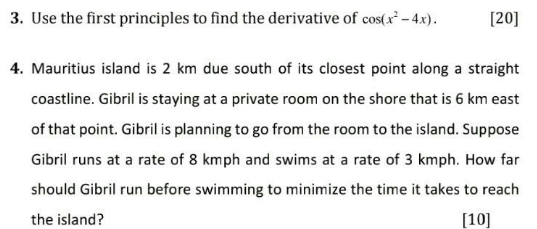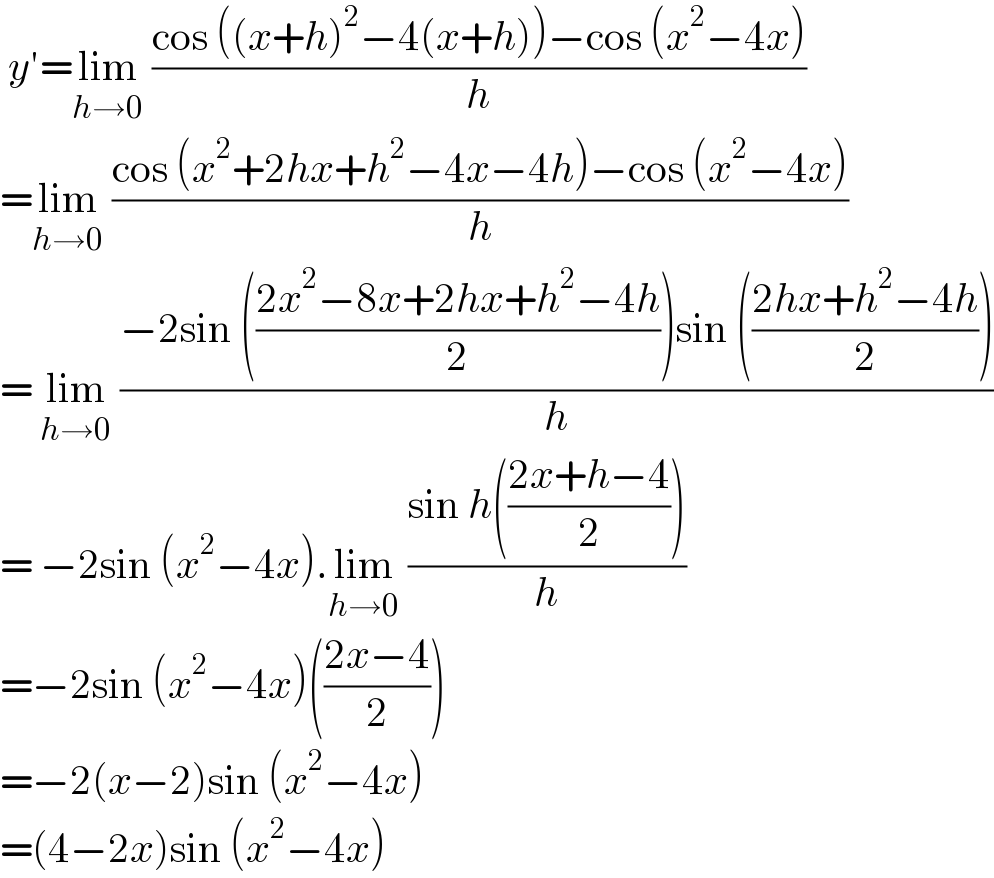Question Number 143134 by help last updated on 10/Jun/21

Answered by liberty last updated on 10/Jun/21

$$\:{y}'=\underset{{h}\rightarrow\mathrm{0}} {\mathrm{lim}}\:\frac{\mathrm{cos}\:\left(\left({x}+{h}\right)^{\mathrm{2}} −\mathrm{4}\left({x}+{h}\right)\right)−\mathrm{cos}\:\left({x}^{\mathrm{2}} −\mathrm{4}{x}\right)}{{h}} \\ $$$$=\underset{{h}\rightarrow\mathrm{0}} {\mathrm{lim}}\:\frac{\mathrm{cos}\:\left({x}^{\mathrm{2}} +\mathrm{2}{hx}+{h}^{\mathrm{2}} −\mathrm{4}{x}−\mathrm{4}{h}\right)−\mathrm{cos}\:\left({x}^{\mathrm{2}} −\mathrm{4}{x}\right)}{{h}} \\ $$$$=\:\underset{{h}\rightarrow\mathrm{0}} {\mathrm{lim}}\:\frac{−\mathrm{2sin}\:\left(\frac{\mathrm{2}{x}^{\mathrm{2}} −\mathrm{8}{x}+\mathrm{2}{hx}+{h}^{\mathrm{2}} −\mathrm{4}{h}}{\mathrm{2}}\right)\mathrm{sin}\:\left(\frac{\mathrm{2}{hx}+{h}^{\mathrm{2}} −\mathrm{4}{h}}{\mathrm{2}}\right)}{{h}} \\ $$$$=\:−\mathrm{2sin}\:\left({x}^{\mathrm{2}} −\mathrm{4}{x}\right).\underset{{h}\rightarrow\mathrm{0}} {\mathrm{lim}}\:\frac{\mathrm{sin}\:{h}\left(\frac{\mathrm{2}{x}+{h}−\mathrm{4}}{\mathrm{2}}\right)}{{h}} \\ $$$$=−\mathrm{2sin}\:\left({x}^{\mathrm{2}} −\mathrm{4}{x}\right)\left(\frac{\mathrm{2}{x}−\mathrm{4}}{\mathrm{2}}\right) \\ $$$$=−\mathrm{2}\left({x}−\mathrm{2}\right)\mathrm{sin}\:\left({x}^{\mathrm{2}} −\mathrm{4}{x}\right) \\ $$$$=\left(\mathrm{4}−\mathrm{2}{x}\right)\mathrm{sin}\:\left({x}^{\mathrm{2}} −\mathrm{4}{x}\right) \\ $$
